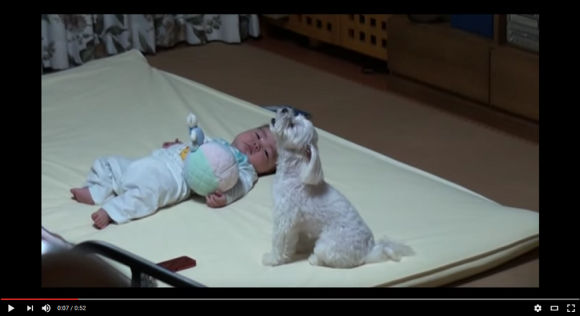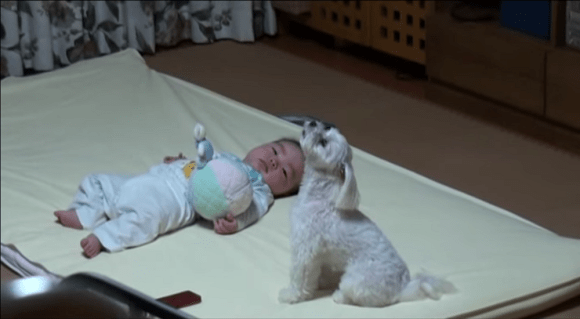
If the unhappy baby doesn’t get the parents’ attention, the friendly canine sure will!
Babies don’t have many options to voice their wants and needs; they can really only cry and then wait for someone to come by and run through the gamut of possible solutions. Through the unhappy noises, parents will check for dirty diapers, try feeding them, rolling them into a more comfortable position, check if they are thirsty, see if they are too hot or too cold – anything to get them to calm down. One adorable Japanese infant is having some sort of difficulty associated with baby life, and begins to voice a complaint, when a surprising third party joins in the cries.
The talkative pooch can’t let its little master suffer either and joins the call with its own unique “wail”. The little tot looks as surprised as we feel and immediately stops crying when the dog joins in.
▼ “And what do you think you’re doing?”
It turns out that domesticated dogs make a whole lot more sounds and calls than their wild ancestor, the wolf. It is hypothesized that during the domestication process, because of their closeness to humans, dogs have learned more sounds in order to better communicate with us (the same theory holds for domesticated cats). Many dog owners can easily differentiate between the different barks and noises that dogs make, much in the same way that babies have different cries.
So while babies and dogs certainly can’t express themselves with enunciated words, there is definitely a communication technique that both babies and dogs can use with their caregivers. Perhaps just as dogs are man’s best friend, they can be baby’s best friend too!
Source, images: YouTube/WaioliCoCo


 6 surprising things about having a baby in Japan
6 surprising things about having a baby in Japan Japanese amusement park opens doors to dogs, lets animals on rides with their owners
Japanese amusement park opens doors to dogs, lets animals on rides with their owners 2025 Osaka World Expo aims to be first in the world to allow dogs, possibly cats too
2025 Osaka World Expo aims to be first in the world to allow dogs, possibly cats too It’s the year of the sheep-dog! Introducing new clothes for your dog’s wardrobe
It’s the year of the sheep-dog! Introducing new clothes for your dog’s wardrobe 7 things that surprise a visitor to Laos 【Photos】
7 things that surprise a visitor to Laos 【Photos】 Life-size vibrating Legend of Zelda Master Sword for sale from Nintendo【Photos】
Life-size vibrating Legend of Zelda Master Sword for sale from Nintendo【Photos】 Yes, our new smartphone looks like at least two Studio Ghibli anime characters, Sharp says
Yes, our new smartphone looks like at least two Studio Ghibli anime characters, Sharp says New Tokyo restaurant charges higher prices to foreign tourists than Japanese locals
New Tokyo restaurant charges higher prices to foreign tourists than Japanese locals Japanese public toilet becomes a tourist attraction in Tokyo
Japanese public toilet becomes a tourist attraction in Tokyo Map of Mexican restaurants across Japan created by Mexican embassy
Map of Mexican restaurants across Japan created by Mexican embassy Studio Ghibli releases art crystal puzzles and folding umbrellas for rainy season in Japan
Studio Ghibli releases art crystal puzzles and folding umbrellas for rainy season in Japan New bento bread makes us rethink sandwiches…and Japanese bentos
New bento bread makes us rethink sandwiches…and Japanese bentos Shibuya strip show-adjacent extra-fatty beef bowl fails and succeeds in impressing us
Shibuya strip show-adjacent extra-fatty beef bowl fails and succeeds in impressing us How to make a secret rice bowl at Ichiran ramen
How to make a secret rice bowl at Ichiran ramen Cheap Japanese ryokan at Kusatsu Onsen is hidden at the back of a traditional store
Cheap Japanese ryokan at Kusatsu Onsen is hidden at the back of a traditional store “Mt. Fuji convenience store” issues apology for bad tourist manners, adds multilingual signs
“Mt. Fuji convenience store” issues apology for bad tourist manners, adds multilingual signs Tokyo’s famous Lost in Translation hotel is closed
Tokyo’s famous Lost in Translation hotel is closed Studio Ghibli releases new mug and tumbler collection featuring Jiji and Totoro
Studio Ghibli releases new mug and tumbler collection featuring Jiji and Totoro Tokyo sweets store sells beautiful soft serve ice creams that look like works of art
Tokyo sweets store sells beautiful soft serve ice creams that look like works of art Japan has nearly 4 million abandoned homes, but where and why?
Japan has nearly 4 million abandoned homes, but where and why? FUK COFFEE?!? Japanese cafe has a perfectly innocent reason for its startling-looking name
FUK COFFEE?!? Japanese cafe has a perfectly innocent reason for its startling-looking name Godzilla leather wallet will make you feel like the King of the Monsters and lord of fashion
Godzilla leather wallet will make you feel like the King of the Monsters and lord of fashion McDonald’s new Happy Meals offer up cute and practical Sanrio lifestyle goods
McDonald’s new Happy Meals offer up cute and practical Sanrio lifestyle goods Foreigner’s request for help in Tokyo makes us sad for the state of society
Foreigner’s request for help in Tokyo makes us sad for the state of society Japanese ramen restaurants under pressure from new yen banknotes
Japanese ramen restaurants under pressure from new yen banknotes Bad tourist manners at Mt Fuji Lawson photo spot prompts Japanese town to block view with screens
Bad tourist manners at Mt Fuji Lawson photo spot prompts Japanese town to block view with screens All-you-can-drink Starbucks and amazing views part of Tokyo’s new 170 meter-high sky lounge
All-you-can-drink Starbucks and amazing views part of Tokyo’s new 170 meter-high sky lounge McDonald’s Japan’s new pancake pie is a taste sensation
McDonald’s Japan’s new pancake pie is a taste sensation More foreign tourists than ever before in history visited Japan last month
More foreign tourists than ever before in history visited Japan last month Sales of Japan’s most convenient train ticket/shopping payment cards suspended indefinitely
Sales of Japan’s most convenient train ticket/shopping payment cards suspended indefinitely Sold-out Studio Ghibli desktop humidifiers are back so Totoro can help you through the dry season
Sold-out Studio Ghibli desktop humidifiers are back so Totoro can help you through the dry season Japanese government to make first change to romanization spelling rules since the 1950s
Japanese government to make first change to romanization spelling rules since the 1950s Ghibli founders Toshio Suzuki and Hayao Miyazaki contribute to Japanese whisky Totoro label design
Ghibli founders Toshio Suzuki and Hayao Miyazaki contribute to Japanese whisky Totoro label design Tokyo’s most famous Starbucks is closed
Tokyo’s most famous Starbucks is closed Doraemon found buried at sea as scene from 1993 anime becomes real life【Photos】
Doraemon found buried at sea as scene from 1993 anime becomes real life【Photos】 One Piece characters’ nationalities revealed, but fans have mixed opinions
One Piece characters’ nationalities revealed, but fans have mixed opinions We asked a Uniqlo employee what four things we should buy and their suggestions didn’t disappoint
We asked a Uniqlo employee what four things we should buy and their suggestions didn’t disappoint “INUPATHY” collar tells you what your dog is thinking via colors and phone messages【Video】
“INUPATHY” collar tells you what your dog is thinking via colors and phone messages【Video】 Japanese ad campaign shows how to stop babies crying – by slurping udon noodles
Japanese ad campaign shows how to stop babies crying – by slurping udon noodles Japanese “Exorcism Holiday Plan” for dogs helps rid them of bad spirits in their unlucky years
Japanese “Exorcism Holiday Plan” for dogs helps rid them of bad spirits in their unlucky years Dog’s response to other dog is perfectly acceptable…for a parkour athlete【Video】
Dog’s response to other dog is perfectly acceptable…for a parkour athlete【Video】 Adorable mandrake root plushie that screams when you pull it out of its pot could be yours soon
Adorable mandrake root plushie that screams when you pull it out of its pot could be yours soon Japan Railways offering ‘Shinkansen for Pets’, includes dog-friendly vacation packages
Japan Railways offering ‘Shinkansen for Pets’, includes dog-friendly vacation packages What does the giraffe say? Video captures baby giraffe’s surprising cry
What does the giraffe say? Video captures baby giraffe’s surprising cry Nurse in China dubbed “Angel Nurse” for breastfeeding child during major surgery
Nurse in China dubbed “Angel Nurse” for breastfeeding child during major surgery Owner walks Segway dog… or Segway dog walks owner?
Owner walks Segway dog… or Segway dog walks owner? Why does a ’90s Japanese drama theme song calm crying babies? An acoustics expert explains
Why does a ’90s Japanese drama theme song calm crying babies? An acoustics expert explains Working like a dog – Old-timey Japanese invention planned to turn pooch power into butter
Working like a dog – Old-timey Japanese invention planned to turn pooch power into butter Helicopter dog would prefer his boy wore water wings
Helicopter dog would prefer his boy wore water wings We piss our pants over and over to find the most comfortable Japanese baby diaper to pee in
We piss our pants over and over to find the most comfortable Japanese baby diaper to pee in Twitter sympathizes with shivering Shiba Inu during a Tokyo thunderstorm【Video】
Twitter sympathizes with shivering Shiba Inu during a Tokyo thunderstorm【Video】 New uber-soft gel dog beds mimic the feeling of lying between owner’s legs for pet pooches
New uber-soft gel dog beds mimic the feeling of lying between owner’s legs for pet pooches
Leave a Reply